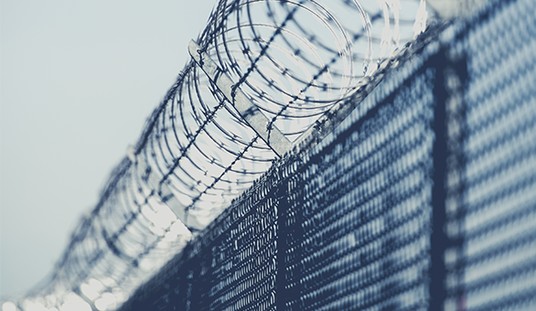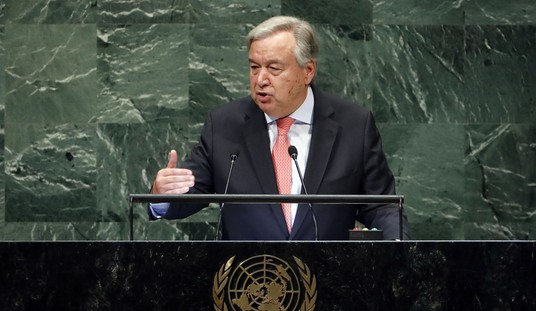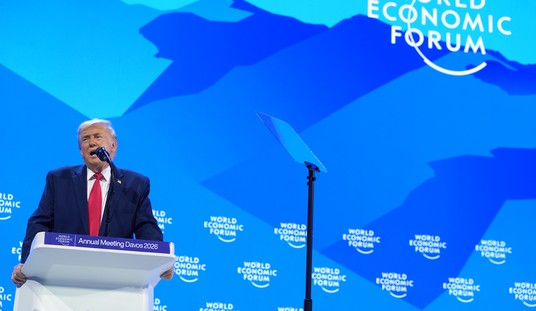Thursday I wrote about the Yale Law School protest of a panel discussion about the First Amendment. At the time, video of the disruption was somewhat limited to a clip showing the initial disruption by students which was loud and very obnoxious (one student told a member of the Federalist Society she would “literally fight you, bitch”). A Yale Law School professor named Kate Stith interrupted the protesters and gave them a warning. She also told them to “grow up” which they didn’t like. Stith added, “You’re welcome to be outside as long as you don’t disrupt the event.”
Yale Law School has a 3 strikes policy related to speech interruptions which means after two warnings bad things can happen to students. So after that warning (and Stith said she’d issue a second warning immediately if they didn’t heed the first one) the students left the room. The 2-minute video clip published by the Free Beacon only covered the initial disruption. The Beacon reported what happened next:
The protesters proceeded to exit the event—one of them yelled “Fuck you, FedSoc” on his way out—but congregated in the hall just outside. Then they began to stomp, shout, clap, sing, and pound the walls, making it difficult to hear the panel. Chants of “protect trans kids” and “shame, shame” reverberated throughout the law school. The din was so loud that it disrupted nearby classes, exams, and faculty meetings, according to students and a professor who spoke on the condition of anonymity.
Ellen Cosgrove, the associate dean of the law school, was present at the panel the entire time. Though the cacophony clearly violated Yale’s free speech policies, she did not confront any of the protesters.
But Slate’s Mark Joseph Stern took issue with the Beacon’s characterization of the protest on Twitter, contrasting the Free Beacon report with one from the Yale Daily News:
The Washington Free Beacon article complains that students protested in the hallway during the event, which irked those attending, but it does not say that anyone's speech was actually silenced. The video also confirms parts of the Yale Daily News report. https://t.co/Q5ny3NCoJt
— Mark Joseph Stern (@mjs_DC) March 17, 2022
So that was the core of the argument that is still ongoing in the media. Did the protesters disrupt the panel once and then leave or did they continue to cause a sustained disruption after leaving the room? Not surprisingly, Stern sided with the Yale Daily News which downplayed the protest after the initial disruption.
At a minimum, I think it is safe to say that YLS' decision to station two plainclothes officers in the room, then call in four armed officers to respond to the protest, was an overreaction.
— Mark Joseph Stern (@mjs_DC) March 17, 2022
Friday, Stern wrote a piece for Slate titled “The Truth About the Yale Law Protest That Prompted a Federal Judge to Threaten a Clerkship Blacklist.” He took some shots at the Free Beacon report.
Aaron Sibarium of the Washington Free Beacon, a conservative outlet…claimed that “more than 100 students at Yale Law School attempted to shout down a bipartisan panel on civil liberties.”
But interviews with participants and witnesses at the demonstration, as well as multiple videos, reveal that this account distorts reality. The students made their point at the very start of the event and walked out before the conversation began. Their exercise in free speech, however rowdy or distasteful, did not prevent the panelists from expressing their views. And their demonstration did not—contrary to the Free Beacon’s reporting—require administrators to summon the police…
Reasonable people can disagree about the students’ decision to disrupt Stith at the outset, but it is clear that they did not prevent the event from moving forward. Some students did ask pointed questions of Waggoner during Q&A, but these remarks were not vulgar or violent. There was some back and forth between audience members and panelists during this portion, but in the form of debate, not crude heckling.
Once outside in the hallway, students continued their protest, and noise undoubtedly bled into the room. But it’s debatable this noise made it “difficult to hear the panel,” as the Free Beacon reported. The conversation remained audible inside the room, albeit with the din of a demonstration just outside.
To prove his point, Stern posted this very brief video in which speakers are talking despite the noise in the background from the protesters out in the hall.
Again, Stern put all of this out Friday afternoon arguing the Free Beacon had basically overhyped the impact of the protest. However that’s not the end of the story. Even before Stern’s story went up at Slate, attorney David Lat who has also been covering the story on his Substack site gathered some additional information which he detailed in a Twitter thread. Basically he learned that the disruption of the protesters was much worse than he’d initially believed. It wasn’t just the free speech panel which was disrupted, it was several other classrooms near where the protesters were chanting and stomping their feet.
2/ It wasn't just the event that was disrupted.
Classes were disrupted too, including Federal Courts (Judith Resnik) and Advanced Legal Writing (Rob Harrison).
The latter was in Room 121—the room farthest away from Room 127, where the event took place.
— David Lat (@DavidLat) March 18, 2022
4/ A student in a classroom who was taking a test on an entirely different floor of the building could even hear the noise from the protest.
In other words, it wasn't just limited to the first floor.
— David Lat (@DavidLat) March 18, 2022
6/ A faculty meeting—the job talk of Professor Claudia Flores, a Latinx legal scholar whose work focuses on international human rights and inequality—was disrupted.
After a few unsuccessful attempts to restart it, the meeting had to be moved to Zoom.
— David Lat (@DavidLat) March 18, 2022
12/ Here’s the account of someone in the room at the Yale Law School protest: @JimmyByrn reports that he “could hear virtually none of it the entire time.” https://t.co/xmpelKWobk
— David Lat (@DavidLat) March 18, 2022
Jimmy Byrn is a real Yale Law student who was present that day. He also tweeted this.
No bias here. The exchange with Prof Stith happened. Protestors left to chant in the hallway. Then re-entered en masse. Asked about 5-6 questions interrupting the speaker several times. Left en masse chanting. Chanted in the hallway til it ended. I could not hear due to the noise
— Jimmy Byrn (@JimmyByrn) March 18, 2022
In addition to those reports of disruption Lat also included five brief audio clips that show how loud the protesters were after they moved into the hallway.
16/ Audio of the Yale Law School event from @ADFLegal, 2 of 5:https://t.co/GTj0VXF2ib
— David Lat (@DavidLat) March 18, 2022
If you listen closely to that second clip above you’ll notice you can barely make out one of the speakers in the room though I can’t really hear what she’s saying. Here’s two more.
19/ Audio of the Yale Law School event from @ADFLegal, 5 of 5:https://t.co/Z4gz1bjpn0
— David Lat (@DavidLat) March 18, 2022
Each of the five clips Lat posted (I left one out but it’s similar) are longer than the single clip Mark Joseph Stern published but it’s still not the full event. Friday afternoon the Free Beacon published an 18 minute audio clip which showed conclusively that the protesters were very disruptive even after leaving the room. No need to listen to all of this but skip through it and you’ll see that at some moments the speakers can be heard and at others the student protesters are drowning them out.
Aaron Sibarium, who wrote the story for the Free Beacon, offered his own take on the validity of Mark Joseph Stern’s critique.
Stern writes: "It’s debatable this noise made it 'difficult to hear the panel." But in the first 18 minutes of the audio, the panelists are repeatedly drowned out. One chant of "protect trans kids" goes on for several minutes, making it very hard to hear the panelists.
— Aaron Sibarium (@aaronsibarium) March 19, 2022
Next, Stern credulously repeats Yale Law School’s claim that the police were not there to escort panelists out of the building. But that’s precisely what the police say they are doing in the audio we obtained: “We have cops lined up to let you guys go out," an officer says.
— Aaron Sibarium (@aaronsibarium) March 19, 2022
I didn’t include the clip of cops talking about the escort out but you can listen to it here.
Kristen Waggoner, the main target of the protest, independently confirmed that the police escorted her and her co-panelist to a patrol car, which then drove them to lunch.https://t.co/t018Oo2I0w
— Aaron Sibarium (@aaronsibarium) March 19, 2022
I would also note that Stern reached out to the Beacon for comment before he published his article. We told him that claim about the police was sourced in the original story—in which we said that three members of fedsoc were told Gerken called the police. Stern omitted this fact.
— Aaron Sibarium (@aaronsibarium) March 19, 2022
Skeptical? Listen to the audio and decide for yourself who's cherrypicking. https://t.co/t018Oo2I0w
— Aaron Sibarium (@aaronsibarium) March 19, 2022
So why does any of this matter? Well, because Yale Law students disrupted an event, not once but repeatedly. They also disrupted other classes, one of which had to be moved to Zoom because of the noise. And despite all of that, Mark Joseph Stern at Slate has put forward a cherry-picked account to claim the protests weren’t really out of line. He then claimed right-wing outlets were using false claims to spread a narrative about left-leaning students.
It’s easy to see why a skewed version of the story is now dominating conservative media. This version plays right into current conservative fears about ostensible liberal censorship on college and law school campuses. Left-leaning students, the narrative goes, are silencing their conservative peers, adopting an illiberal view of free speech that seeks to stamp out dissent from the right.
This is almost the opposite of reality. There’s plenty of evidence that the student protesters adopted an illiberal view of speech. They rudely interrupted the event when it started and even after leaving the room they made every effort to continue the disruption in the hall. Sometimes the speakers in the room could be heard and sometimes they couldn’t. Posting a cherry-picked 13 second clip from the front row during a moment when the speakers could be heard doesn’t disprove that at many other times they could not be.
The best you can say here is that the student protesters didn’t manage to get the event shut down though they clearly tried to disrupt it throughout. Credit for continuing the panel belongs to the speakers and listeners who persevered despite the mob’s activity. It should not accrue to the protesters themselves who, mostly thanks to the timidity of Yale Law deans, managed not to officially violate the rules against using the heckler’s veto.








Join the conversation as a VIP Member